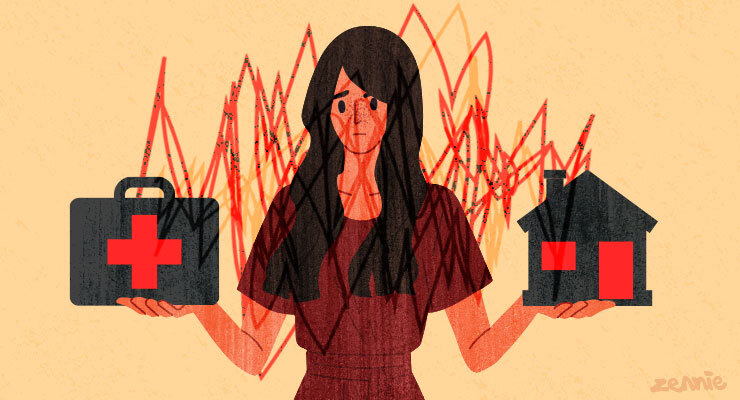
There is an indelible link between housing and health in Australia.
Housing is a psychological need as well as a social determinant of health, meaning unstable, unaffordable and substandard housing leads to poor health outcomes and high health costs. Consequently, sustained exposure to housing affordability problems has long-term mental health impacts.
As this era of extreme housing affordability stress continues, we are silently and studiously seeding a mental health epidemic. And government response to the housing crisis is so siloed that it is unclear whether downstream impacts are even considered, let alone modelled.
There is an opportunity cost in allowing a significant proportion of the community to unwittingly walk into a perpetual cycle of housing anxiety, deteriorating health and medical debt, which ultimately contributes to a recurring cycle of stress.
So why are we not fighting to prevent long-term damage to individuals, communities and even our economic productivity?
Debt
It is well established that debt detrimentally affects mental health (independent of socioeconomic status), with individuals affected by debt at greater risk of depression, anxiety, suicide, suicidal ideation, substance abuse and psychotic disorders. There is also increasing evidence of a direct association between unaffordable housing and poor mental health.
Severe housing stress creates an environment where people are constantly juggling essential expenditures, such as medical bills, with the need to keep a roof over their heads. These household expenditure compromises represent the (sometimes daily) task of minimising and delaying expenses.
Those facing medical debt may compromise seeking or receiving appropriate medical care, which can lead to a delayed diagnosis of health conditions and potentially contribute to increased risk of premature mortality and poor mental health outcomes. These decisions will have varying effects, all with downstream cost impacts for our health and hospital systems.
But the first impact household expenditure compromises are likely to have, with an immediate public policy and budgetary cost impact, is on mental health. With an increasingly unstable housing market, out-of-pocket spending on health will be increasingly compromised across a more diverse cross-section of households.
Health costs
Chronic illness can damage the economic well-being of individuals and their households, with financial consequences including unemployment and reduction in paid employment, as well as increased costs of ongoing treatment and support.
Despite continued commitments from all governments to publicly fund essential care and support, out-of-pocket spending on health services has steadily increased over the past 25 years in Australia. Individuals spent an estimated $33.2 billion on health goods and services in 2020-21, equating to an average of $1293 a person.
These increasing medical costs have coincided with stagnating wage growth, a decay of the primary healthcare system, and booming rates of chronic illness. This combination is driving the spike in financial hardship associated with medical debt.
Primary healthcare is also in crisis. A recent Grattan Institute report reveals that Medicare, Australia’s universal healthcare system, has failed to keep up with changes to Australians’ health needs since it started in 1984.
The report also highlights how other countries have reformed general practice, leading to a drop in avoidable hospital visits. However, in Australia, we spend more on hospitals while neglecting general practice: the best place to tackle chronic health conditions.
Government spending
According to the Australian Institute of Health and Welfare, 7.6% of government health expenditure was spent on mental health-related services in 2019-20, the same percentage spent in 2015-16. However, during this time there has been a decline in home ownership, an increase in the number of private renters, rising housing and rental costs, and an ongoing decline of social housing stock in relation to population growth. In fact, new data shows housing stress has become one of the top three risk factors for suicide.
The Productivity Commission has estimated the direct economic costs of mental health at between $43 billion and $70 billion, with an additional $151 billion due to the cost of disability and premature death. Even if mental health funding was doubled overnight, the government would still get a positive return on investment. For individuals needing access to care, this investment would be life-changing.
Considering the net benefit to the economy, the recent decision to reduce the number of mental health sessions for which people can receive a Medicare rebate seems counter-productive. Our local economies and communities will benefit not from more people receiving fewer mental health services, but from everyone getting the services they need.
We cannot afford to ignore the millions of Australians who need more affordable and accessible mental healthcare, the increasing demand for which over the coming years will be inextricably linked to less affordable and accessible housing. The overall viability of our healthcare system, for generations to come, will depend on it.
Have you experienced poor mental and/or physical health due to housing stress? Let us know by writing to letters@crikey.com.au. Please include your full name to be considered for publication. We reserve the right to edit for length and clarity.









The cracks which used to swallow the most unfortunate have been cultivated by neoliberal filth to become ravening chasms, gobbling up what used to be the lower end of the middle class. And those shiny-shoed scum would tell you that’s as it should be.
I want to know why we ever gave such obvious con-men a toehold. Who looks at the US and says, that’s the sort of precarity and viciousness I want for my society?
And how does it comes to pass that someone who identifies as a leftie, who was raised by a single mum in a housing commission, is kicking everyone but the filthy rich in the teeth with the insane stage three tax cuts? Why doesn’t he want to raise Newstart one iota? Why is it business as usual for fossil fuels?
I’m getting pretty damn fed up with unceasing neoliberal insanity being brutally rammed through… Starting to think I’d like to see some small pieces of lead brutally rammed through.
Yep, every time the lease renewal comes up and the rent is raised ‘in line with market expectations’, I feel the same way. But at least I have a place. For now. This whole business is a slow-motion train wreck in progress. Wait another three years when even more people are at the edge of insanity, homeless, or so desperate that they’ll consider burning down the offices of the worst offenders. Wait until our version of Donald Trump declares he or she will fix the problem. Sure, everyone will know they’re lying, but sometimes – like Trump – people vote out of anger, not sense.
Turning Australia into America 2.0 has been bipartisan policy for decades, probably generations.
New Labor leaders believe they can file down some of the sharper edges while they do this so the end result is not quite as brutal, but they are wrong.
It’s classic Maslow hierarchy of needs and shelter is a foundational one, along with air, water and food. Mental health treatment can’t help house somebody, nor can active listening, empathy and unconditional positive regard (thanks Carl Rogers). No additional psych sessions can fix a societal catastrophe. It’s a diversion from the real issues here. Better the money is spent to close the gap from the inadequate rebate?
When there’s widespread unmet need for mental health treatment, there are going to be a vast number of associated costs, dwarfing the cost of providing the treatment.
But what is offered is not treatment. Neither therapy nor medication has any evidence of success. In fact the more contact a person has with the mental health industry, the worse and more entrenched their problems become.,
Not in my experience.
Appropriate medication and therapy saves lives.
Social support is also very important.
Absolutely!
It’s the social determinants of health, not just mental health.
We could go a long way towards improving both physical and mental health outcomes by increasing the supply of social housing and increasing Centrelink payments and the minimum wage.
109%
Big thumbs 🙂
Raising Centrelink payments and the minimum wage isn’t enough- not now. Dual income working families are increasingly finding themselves homeless, too, due to lack of rental stock. It’s not just a question of income- not anymore. It should never have been allowed to get this state. Meanwhile, the tiny amount of public housing we do have sometimes sits empty because it’s set aside for the lowest possible income groups, only. We needed to increase the public housing stock at least two decades ago. Instead we did the exact opposite.
Homeless only if the dual income family just want to live in a large McMansion near the water.
There should be more drastic cuts in mental health Medicare benefits and more diverted to the repair of physical ailments. Mental health has not and is not quantifiable as to outcome – all the vicissitudes of life are stressful but don’t require Medicare funding to overcome them. Prof Hickie’s apetite for more and more money for mental health is insatiable. Objectively Australia must be the nuttiest country on earth- most people in the world are looking for , food, housing and a job. In Australia if a teenager breaks up with their girlfriend/boyfriend /puppy dog they receive a mental health plan for psychologist for counselling with no end date and no limits on Medicare funded chats with no outcome .
So the government imposed limit is to be commended – next the government should publish a list of the established Mental Health diagnoses which Medicare would fund.
The other waste pit of Medicare funding is the chronic disease allied health freebies. The government should publish a diagnostic list which is regarded as a chronic disease that attracts this Medicare benefit. At present an untreated ingrown toenail qualifies for chronic disease with yearly free Medicare funded physiotherapy, mental health , chiropractic , exercise physiology benefits.
agree, everything is based on the victim mentality
Medicare needs to get back to the basics
The cutting of 10 sessions is 100% the right thing to do. Ian Hickie is 100% correct.
No doubt housing is a significant factor in causes of ill physical and mental health.
The ideological madness of privatisation and atomisation of services costs us a bloody fortune and is simply unsustainable. It’s simply helped a few psychologists and so called counsellors get a reliable source of public money (the gravy train) a cost shift of public money into private hands. This is even worse if not catastrophic in the NDIS.
Apart from social housing what is needed is salaried professionals working in not for profit NGO’s or Government provided services. It’s enough that the Medicare umbilical cord is funding part of the Medical profession it is simply wasteful in the extreme to extend this to other private providers.